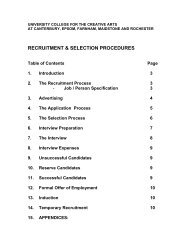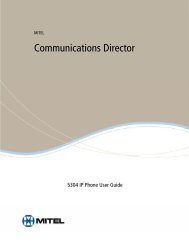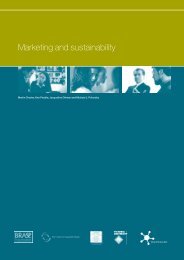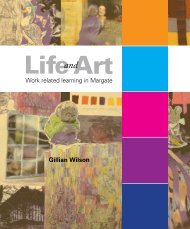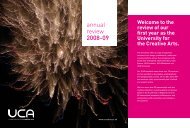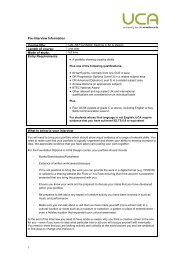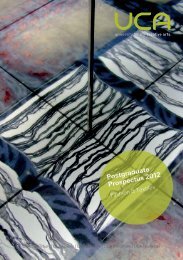John Hinchcliffe
John Hinchcliffe
John Hinchcliffe
- No tags were found...
You also want an ePaper? Increase the reach of your titles
YUMPU automatically turns print PDFs into web optimized ePapers that Google loves.
during this period started from guidelines discussed with the client. Workingdrawings would be produced after a site visit, and then the plan of the workwould gradually take shape. Michael Regan described ‘the heaps of rugs...scattered around his loom...as he works he picks pieces from these moundsand adds them to his weaving as they suggest new combinations or colours.In this way his rugs acquire a random quality which creates liveliness andfreedom of movement across their surfaces’. 12<strong>Hinchcliffe</strong> also thought beyond the individual work, seeing his output as awhole, a dramatic sequence of pieces with related themes and colour ways. Hisdevelopment of the idea of the series in textiles was to have a strong influenceon the later decision to work in ceramics. It gave an intellectual foundationto the purpose of making tablewares where repeat patterns were fundamental,where a ‘line’ could be developed consistently over a period of years, andwhere a ‘look’ could be fashioned for the wider market. It was not so great aleap to move from the textile studio concentrating on the individual uniquework to the ceramic studio concentrating on multiples of individualistic,but not necessarily unique, named pieces. It could be construed as a naturalprogression for an ambitious creative practitioner who wanted to explore alarger body of design ideas more quickly, and in a more social setting.<strong>Hinchcliffe</strong>’s commitment to this seven-year period of work as a textile artistmay also be understood, to some degree, as a self-taught apprenticeship intechnique, creativity and in the economics of craft. His genuine interestin the process of selling and working with the client, and in the value ofplacing work in public collections, were also forged at this time. <strong>Hinchcliffe</strong>remarked during a teaching engagement at the Tasmanian College ofAdvanced Education in the 1970s, that he always focused on the audiencewhen considering a new piece.‘I consciously tried to reach design firms or critics or people involved in thearts. In a way I sold my pieces from the point of view of where they wouldbe and who would see them, rather than how much I would get for them. Itwas quite a long-term publicity exercise’. 13The frustration of this process is clear. It took such a long time to completeeach work, and <strong>Hinchcliffe</strong> began to consider alternatives. He resolved theproblem by changing his material, and exerting a more complete controlover making, selling and distribution, through the <strong>Hinchcliffe</strong> and Barberpartnership. In this model, the maker is more likely to gift important workto public collections than to negotiate a sale, as happened by gifts of earlyspongeware ceramics to the Salisbury Museum, Wiltshire in 1983, after agroundbreaking exhibition in the same year at the Salisbury Arts Centre.This new model was deeply important for <strong>Hinchcliffe</strong>. It offered newcreative opportunities, the chance to work with new materials, and, becausesignificantly more work could be made and sold, a more profitable outcomewas realised. Seven long years in the textile studio, producing perhaps tenor fifteen works a year was by any account, a committed exploration of onemethod of working. In a less confident or resourceful maker it could have ledto compromise or economic failure. <strong>Hinchcliffe</strong> took the long-term view. Helearned how to put a plan into operation. He could see how his design ideashad both immediate impact on the unique work in hand, but also helpedto support future activity where refinement, testing and trial were essentialcomponents of the creative process. His ideas needed to be translatable tothe studio setting, where other makers would bring them to life. <strong>Hinchcliffe</strong>remarked on this process in his article on ‘Colour’ in The Weavers Journal:‘The gap between conceiving an idea and finishing it is sometimes very wide;therefore I prefer to make the initial ‘idea’ only, and the work grows and10 J o h n H i n c h c l i f f e J o h n H i n c h c l i f f e 11





